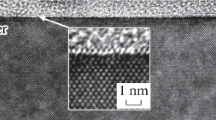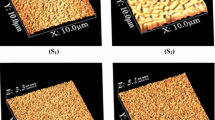Abstract
Self-organized nanostructures are increasingly important for novel optoelectronic devices, as high densities of quantum dots can be deposited directly during heteroepitaxial growth. Due to the elastic relaxation in 3D nanostructures, properties differing from 2D systems can be achieved, e.g., higher Ge contents in SiGe islands than in planar layers with the same total amount of Ge can be realized, enhancing the design freedom for, e.g., detectors or high frequency transistors. However, when such nanostructures are overgrown, which is inevitable for any application, they often undergo significant changes, partly eliminating their distinct advantages. We present an investigation of SiGe islands formed by deposition of pure Ge on Si (001). X-ray scattering and diffraction is employed to obtain the shape, strain and Ge distribution in uncapped as well as Si-capped islands. For the analysis, model calculations of the strain fields are required. The finite element method is used for uncapped islands, for buried nanostructures a novel analytical approach has been developed. For Tgrowth ≃ 650°C, optimized for island formation, the Ge content in the top part of uncapped islands reaches 100%, at an elastic relaxation of about 50%. During capping, the maximum Ge content considerably decreases to about 50%. At the same time, the islands become very flat, with a decrease in height from 13 to 6nm accompanied by an increase in base diameter from about 100 nm to 180 nm. The elastic relaxation decreases to about 2.5%, so that the buried islands have properties not very much different from 2D layers. Lowering the growth temperature for the Si cap, this effect can be avoided, for Tgrowth as low as 460°C, the structure of the uncapped islands can indeed be preserved.
Similar content being viewed by others
References
O.G. Schmidt, U. Denker, M. Dashiell, N.Y. Jin-Phillipp, K. Eberl, R. Schreiner, H. Gräbeldinger, H. Schweizer, S. Christiansen, F. Ernst, Mat. Sci. Eng. B89, 101 (2002).
D. Bimberg, M. Grundmann, and N. N. Ledentsov, Quantum Dot Heterostructures (Wiley, Chichester, 1999).
For a series of articles on self-organized dots see, MRS Bulletin 23(2), (1998).
P. Sutter, M.G. Lagally, Phys. Rev. Lett. 81, 3471 (1998).
E. Mateeva, P. Sutter, and M. G. Lagally, Appl. Phys. Lett. 74, 567 (1999).
O.G. Schmidt, U. Denker, S. Christiansen, F. Ernst, Appl. Phys. Lett. 81, 2614 (2002).
A.J. Steinfort, P.M.L.O. Schölte, A. Ettema, F. Tuinstra, M. Nielsen, E. Landmark, D.M. Smilgies, R. Feidenhans’l, G. Falkenberg, L. Seehofer, R.L. Johnson, Phys. Rev. Lett. 77, 2009 (1996).
A.A. Darhuber, P. Schittenhelm, V. Holy, J. Stangl, G. Bauer, G. Abstreiter, Phys. Rev. B 55, 15652 (1997).
T.H. Metzger, I. Kegel, R. Paniago, J. Peisl, J. Phys. D: Appl. Phys. 32, A202 (1999).
Q. Shen, S. Kycia, Phys. Rev. B 55, 15791 (1997).
I. Kegel, T.H. Metzger, P. Fratzl, J. Peisl, A. Lorke, J.M. Garcia, P.M. Petroff, Euro-phys. Lett. 45, 222 (1999).
Th. Wiebach, M. Schmidbauer, M. Hanke, H. Raidt, R. Köhler, H. Wawra, Phys. Rev. B 61, 5571 (2000).
M. Schmidbauer, Th. Wiebach, H. Raidt, M. Hanke, R. Köhler, H. Wawra, Phys. Rev. B 58, 10523 (1998).
J.R. Levine, J.B. Cohen, Y.W. Chung, P. Georgopulos, J. Appl. Cryst. 22, 528 (1989).
J.R. Levine, J.B. Cohen, Y.W. Chung, Surf. Sci. 248, 215 (1991).
M. Rauscher, R. Paniago, H. Metzger, Z. Kovats, J. Domke, J. Peisl, H.D. Pfannes, J. Schulze, I. Eisele, J. Appl. Phys. 86, 6763 (1999).
T. Roch, V. Holý, A. Hesse, J. Stangl, T. Fromherz, G. Bauer, T.H. Metzger, S. Ferrer, Phys. Rev. B 65, 245324 (2002).
sample A contains a second layer of capped islands, but the scattering experiment has been performed in a geometry with grazing incidence, so that only the topmost layer of islands is visible.
The growth temperature cannot be lowered arbitrarily, as this results in an increasing number of defects in the grown crystals.
Author information
Authors and Affiliations
Rights and permissions
About this article
Cite this article
Stangl, J., Hesse, A., Holý, V. et al. Structural properties of SiGe islands: Effect of capping. MRS Online Proceedings Library 749, 213 (2002). https://doi.org/10.1557/PROC-749-W21.3
Published:
DOI: https://doi.org/10.1557/PROC-749-W21.3




